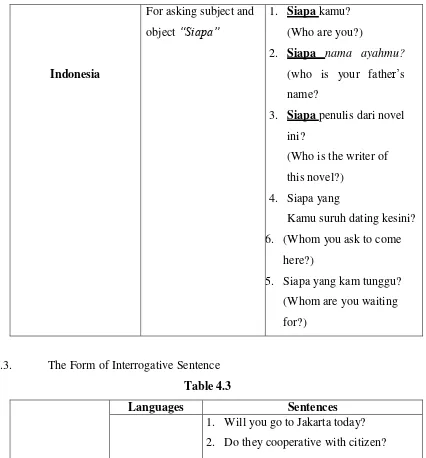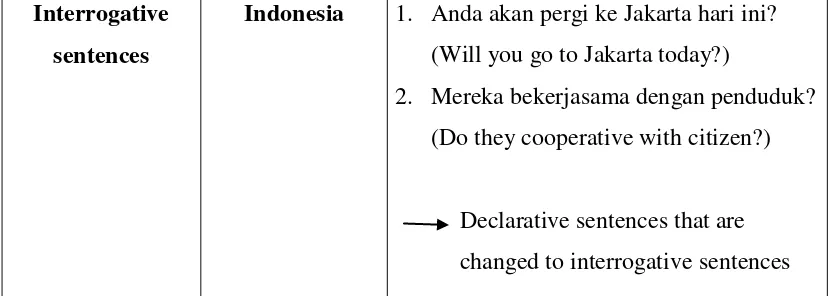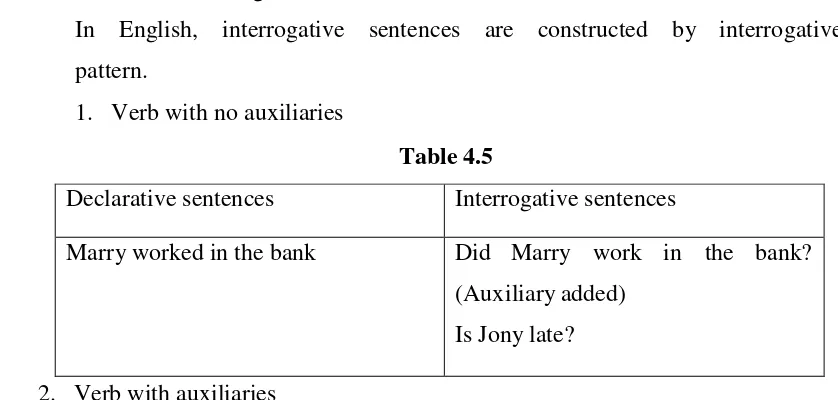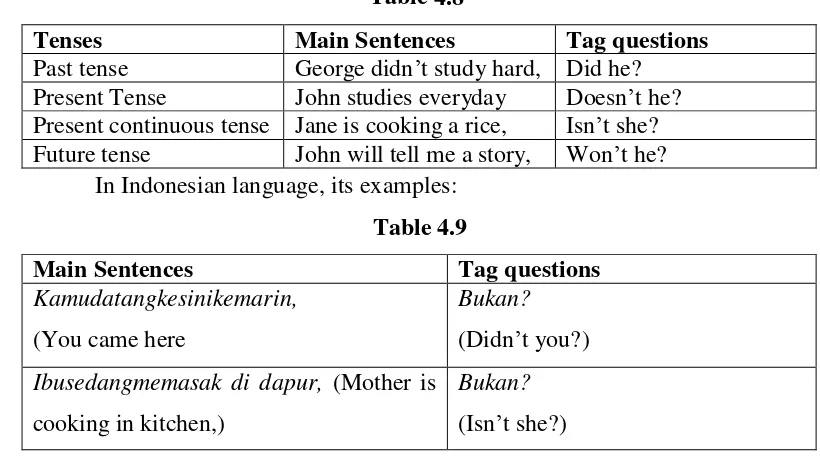33 A CONTRASTIVE ANALYSIS OF INTERROGATIVE SENTENCES IN ENGLISH
AND INDONESIAN LANGUAGE
Khoirul Huda1
Abstract : Human beings are social creatures. They need a language for communication. A human being who came from different country has different language for communication. Although the languages are different, those have some similarities. The similarities of languages make the students easy to learn the languages as second or foreign languages. However, the differences of languages cause students face some difficulties to learn other languages. This research has analyzed some differences of interrogative sentences in English and Indonesian language in order to contribute positively in language learning and teaching. This research uses a method to know the differences between two languages. The method is contrastive analysis. Contrastive Analysis is a method of language analysis that popular in linguistic study in middle of 20th century. This method is used to contrast between two languages that have differences. Through this method, linguists or language learners find the differences which make them find the difficulties of languages which make them find the conveniences in learning. Interrogative sentences that have been analyzed in this research are sentences have essential roles in communications and learning language process too. Through this sentence, questioners obtain some information from respondent and teachers also invite the students’ idea. Before analyze the differences between two languages, this research presents the data presentation that explains the kinds of interrogative sentences in English and Indonesian language clearly. Then, researcher contrast two languages to find out differences of them. The differences between two languages are found, such as in placing of question words, the use of “who”, the form of interrogative sentences, tag questions. Based on this analysis can be known that interrogative sentences in English and Indonesian language have brief differences. The research findings have been found based on the structure and the uses of sentences.
Keywords: Contrastive Analysis, Interrogative sentences, English Language, and Indonesian Language.
1
34 Introduction
From these common functions, it can be identified as special functions such as, a
tool to run the administration, a unifier of ethnic group in Indonesia that has different
languages and an acceptor of cultures. Lado2 states “Language is intimately tied to man’s
feeling and activity. It is bound up with nationality, religion, and feeling of self”. Through
language, human can express happiness, love and sadness to others.
English is an international language. In Indonesia, English as a foreign language
has significant revolve in learning process. Indonesian students have been expected to
master English in order to apply it for communication to native speaker.3 states “Learning
a second language is defined as acquiring the ability to use its structure within a general
vocabulary under essentially the conditions of normal communication among native
speakers at conversational speed”.
Indonesian Language is national language and first language for Indonesian that is
used to communication. It has fundamental role as the means of communication among
people throughout Indonesia. Therefore, the Indonesian grammar teaching is
the essential for Indonesian students to understand comprehensively their own national
language.
Ressult Tabbert says that grammar teaching could enrich the content of English
students learning. He states that grammatical teaching could make the children construct
an English basic sentence. Language can be said means of communication which is not
only in form of written language but also in spoken language. The success of
communication process is affected by the meaning of words. Some words have a unique
characteristic in meaning. Language usage in communication, dialogue has main purpose.
To open the dialogue, it usually uses interrogative sentences or questions. Humans can
obtain some information through apply interrogative sentences in conversation.
Interrogative sentences can be used to ask information, permission, confirmation,
explanation and expanded the dialogue.
Interrogative sentence or question is one part of speaking skill and has essential
2
Robert Lado. Language Teaching.United Stated of America: McGraw Hill. Lopez, Louis. 2009. Oxford. (New York: Oxford University Press, 1964), hal.11.
3
35
function in dialogues. In language learning, interrogative sentence is one part of
grammatical learning for English and learning and have been taught as the basic
grammatical learning.4 says “Each language has a restricted number of patterns of
sentences. These patterns of expression are associated with sentence meanings such as
question, report, and call”. Each kind of sentence has different pattern based on the
purpose of sentence.
In English and Indonesian are somehow different in some ways. To know the
differences, the researcher will use the contrastive analysis. Contrastive Analysis
Hypothesis (CAH) state that the obstruction of second language acquisition is
interference of the first language system and the second language system”. In this
research, the researcher will contrast interrogative sentences between Indonesian as
first language and English as foreign language. Moreover, the language learner
could understand the differences of interrogative sentences in English and Indonesian
language clearly. They will know how to construct good interrogative sentence in both of
languages that have main advantage in communication.
Review of Related Literature
In this part, the researcher presents theories related to the topic. The definitions of
contrastive analysis which are presented by some experts. Brown5 says that “Contrastive
analysis hypothesis state that the main obstruction of second language acquisition is the
interferences system of first and second language”. This theory can conduct the using of
contrastive analysis in Indonesia for English language learning as a foreign language.
Since this study is about contrastive analyzing interrogative sentence, the
researcher will present what is meant by definition of interrogative sentence, types of
interrogative sentence and examples in English and Indonesian languages. Interrogative
sentence is a type of sentence that asks a question. (Compare with sentences that make a
statement, deliver a command, or express an exclamation). Keraf6 says “Interrogative
sentence is a sentence for asking an information about something”.
4
Robert Lado. Language Teaching…,12
5
36
In English or Indonesia, i nt e rro gat i v e sentences have many types. In
English, The characteristics of Interrogative sentences in English language are as follows:
(1) with a rise in pitch, (2) use question mark (?), (3) for asking something or some
information. Frank7 states that “Interrogative sentences or questions in English are divided
to 3 kinds: (1) Yes / No Questions, Frank states that, “These (Yes/ No questions) are
simple questions eliciting the answer yes or no only”. This sentence is started by
auxiliary verb, (2) Interrogative Words Questions. Azar8 says “An information question is
a question that asks for information by using question words”. Commonly, it is named
information question. The question usually is formed by question word such as: what,
where, why, who, which, When, whom, whose, how, and (3) Tag Questions. Tag
Questions are attached or tagged onto the ending of a declarative statement. Elan says
that tag questions are questions that are added by to-be and auxiliary verbs in the end of the sentences. They transform declarative sentences into interrogative
sentences. The function of tag question is for give an asserting to listeners.
Meanwhile, interrogative sentences in Indonesian are also varied too. The
characteristics of Interrogative sentences in Indonesian language are as follows: (1) with a
rise in pitch, (2) use question mark (?), (3) use partikel- kah(suffix-kah) or apakah(what),
(4) Asking an information.
Keraf9 (1991:204) says that interrogative sentences are divided to 3 kinds, as
follows: (1) Total Questions. Keraf10 states “Total Questions are interrogative sentences
or questions that ask complete information. This sentences are answered by “Ya” (Yes) or “Tidak”(No) and usually use question word “apakah”(what) or “partikel –kah” (suffix-kah), (2) Partial Questions. Murdiwiyono (2009:90) says “Partial Questions are
interrogative sentences or questions that are answered based on the question words”.
This sentences usually use question words, such as siapa (who), berapa (how
much/many), kapan (when), dimana (where), bagaimana (how), apa (what),
6
Gorys Keraf. Tata Bahasa RujukanBahasa Indonesia. Jakarta: Grasindo. Kezhavarz, 1991), 204 7
Gorys Frank, Modern English a Practical Reference Guide. ( New Jersey. Prentice Hall, 2972), 88. 8
Bety Schrampfer Azar, Fundamentals of English Grammar. ( New Jersey: Prentice Hall International, 1941), 128.
9
Gorys Keraf. Tata Bahasa…, 204
10
37 mengapa (why), and (3) Rhetorical questions. Keraf11 (1991:205) says that, “Rhetorical
Questions are questions or interrogative sentences are not required answers”. This
sentences usually use in language style and speech or conversations that
listeners have known the answers of the questions.
Research Methodology
The researcher discusses the research methodology. Research design is divided into
two kinds, qualitative and quantitative research. These differ in many ways, but they
complement each other in this way, as well. In this research the researcher uses
qualitative, since the researcher does the instrument. In this research, the researcher uses
qualitative research.12
Data serve as the foundation for a research study. In qualitative research, the
relevant data derive from four field-based activities: interviewing, observing, collecting
and examining (materials), and feeling. An initial observation is that the word “data”
appears as both a plural and singular noun. According to Yin (2011: 130), “Data refers to
a collection of organized information, usually the result of experience, observation,
experiment. . . . This may consist of numbers, words, or images, particularly as
measurements or observations of a set of variables”.The data of the study was English and
Indonesia interrogative sentences. The objects those were analyzed consisted of the
description of interrogative sentences English and Indonesia that will be-main of this
study.In theresearcher,the researchertakes severalbooks in the library as data sources, such
as books, paper, internet, etc. they are especially English books and Indonesia book.
To get the objective, the researcher takes some procedures or steps as follows:
1. The first, the researcher reads first the books both English and Indonesia books
containing of sentence, interrogative sentence. Whereas from spoken language, the
researcher records the colloquial expressions that Indonesian and English people
use to communicate.
2. The Second, the researcher looks for Indonesian and English interrogative
11
Gorys Keraf. Tata Bahasa…, 205 12
38
sentence used.
3. The third, the researcher describes the types of interrogative sentence in the English
and Indonesia language.
4. The four, the researcher compares and contrasts interrogative sentence
between Indonesia and English language.
5. The five, the researcher makes conclusions through the results of the
contrastive analysis of interrogative sentences in English and Indonesia language.
Findings and Discussions
1. Findings
This Research, the researcher finds the differences between Indonesian
and English languages of interrogative sentences. In interrogative sentences, both of
languages have some differences are found in research. The followings are the
differences:
1.1. The place of question words
Table 4.1
Interrogative Sentences
Languages Sentences
English
1. Whendo you study?
2. Whatis your mother’ name? 3. Where are my shoes? 4. How are you?
39 Indonesia
1. Kamu mau belajar kapan?
(When do you study?)
2. Nama ibumu siapa? (What is your mother’
name?)
3. Sepatu sayadimana? (Where are my shoes?)
4. Kabar kamu bagaimana?
(How are you?)
5. Kamu melakukan itukenapa? 6. (Why did you do that)
1.2. The Use of “Who”
Table 4.2
Languages Functions Sentences
English
For asking subject
(who)
1. Who are you? 2. Who is your father’s
name?
3. Who is the writer of this novel?
For asking object
(whom)
4. Whom you ask to come here?
40 Indonesia
For asking subject and
object “Siapa”
1. Siapa kamu? (Who are you?)
2. Siapa nama ayahmu?
(who is your father’s
name?
3. Siapa penulis dari novel ini?
(Who is the writer of
this novel?)
4. Siapa yang
Kamu suruh dating kesini?
6. (Whom you ask to come
here?)
5. Siapa yang kam tunggu?
(Whom are you waiting
for?)
1.3. The Form of Interrogative Sentence
Table 4.3
Languages Sentences
English
1. Will you go to Jakarta today?
2. Do they cooperative with citizen?
41 Interrogative
sentences
Indonesia 1. Anda akan pergi ke Jakarta hari ini? (Will you go to Jakarta today?)
2. Mereka bekerjasama dengan penduduk?
(Do they cooperative with citizen?)
Declarative sentences that are
changed to interrogative sentences
1.4 Tag Questions
Table 4.4
Tag Questions Languages Sentences
Tag Questions English
1. Ali is good, isn’t he? 2. My teacher went to
Japan, didn’t he? 3. I am a student, aren’t I? 4. She will invite us, won’t
she?
42 Indonesia 1. Ali anak yang
baik,bukan?
(Ali is good, isn’t he?) 2. Guru sayapergikeJepang,
kan?
(My teacher went to
Japan, didn’t he?)
3. Saya seorang pelajar, bukan? (I am a student, aren’t I ?)
4. Dia akan mengundang kita,
kan?
(She will invite us,
won’t she?)
5. Salsa kelihatan pucat, bukan? (Salsa looks pale,
doesn’t she?)
2. Discussions
After the researcher present the differences of interrogative sentences in
English and Indonesian language, the discussion of research findings apparent that
both of two languages have brief differences.
2.1 The placing of question words
The placing of question words in English and Indonesian language has
brief difference. In English, question words are placed in the beginning of
sentences13. For examples: (1) What time is it?, (2) Whose car is that?, and (3)
Does his car run well?. In Indonesian language, the question words can be
placed in the beginning and the end of sentences. Most of the moving of
the question words are not influence to sentences’ constructions, except “siapa”(who) and “apa”(what). For examples: The moving of question words
13
43
are not influence to sentences’ construction (with the question words except “siapa”(who) and “apa”(what)). (1) Kemana Keluarga Daryantoakan pindah?, (2) Keluarga Daryanto akan pindah kemana?. The moving of
question words influence to sentences’ construction (with the question words of “siapa”(who) and “apa”(what)).
2.2 The use of “who” or“whom” and “siapa”
In English, “who” is used as subjects or objects in sentences and “whom” is used as objects only. When “who” is used as subjects, it is followed by an affirmative verb (Martinet, 1986:71). For this function,
Azar (1941:132) states that “question word order is not using, no form
of do is used”. “who” and “whom” can be used as objects of a verb (martinet, 1986:71). For examples: (1)Who did you see? (Who as subject), and (2) Whomyou ask to come here? (Whom as object).In Indonesian, “Siapa” (who) is used as subjects and objects14. When as subjects, it is placed in the beginning of sentences and placed in the end of sentences when
it is an object. For examples:
(1) “Siapa”(who) is an object Dia mencari siapa? and (2) Siapa”(who) is
used as subjects. Siapa pemenang perlombaan ini ?
2.3 The form of interrogative sentences
In English, interrogative sentences are constructed by interrogative
pattern.
1. Verb with no auxiliaries
Table 4.5
Declarative sentences Interrogative sentences
Marry worked in the bank Did Marry work in the bank?
(Auxiliary added)
Is Jony late?
2. Verb with auxiliaries
14
44 Table 4.6
Declarative sentences Interrogative sentences
Marry is working in the bank Is Marry working in the bank?
In Indonesian language, according Chaer (2009: 189) stated that “Interrogative sentence is the sentence expected an answer verbally. This answer can be confession, remark, reason or opinion from listener or speaker.
Table 4.7
by auxiliary verbs in the end of the sentences. The functions of tag questions are to assert the statement in sentences. In English has various pattern
based on the tenses of affirmative sentences’ form. These are equal tenses
between main sentences and tag questions.15 For examples:
Table 4.8
Tenses Main Sentences Tag questions
Past tense George didn’t study hard, Did he?
Present Tense John studies everyday Doesn’t he?
Present continuous tense Jane is cooking a rice, Isn’t she? Future tense John will tell me a story, Won’t he?
Ibusedangmemasak di dapur, (Mother is
cooking in kitchen,)
Bukan?
(Isn’t she?)
15
45 Marry akanpergibesok, (Marry will go
tomorrow,)
Bukan?
(Won’t she?)
The explanations above can be known the differences of interrogative
sentences in English and Indonesian language have shown briefly through
contrastive analysis method.
Conclusion
Concerning the differences mentioned above, the following predictions are
derived from the contrast of two languages in terms of making questions: due to the facts
that questions in Indonesian and English language have many common features. In
English, Frank states “There are three kinds of questions in English: (1) Yes - No
Questions, Yes-No Questions are questions or interrogative sentences are answered by “Yes” or “No”. (2) Interrogative word questions are questions that ask information by question words in sentences. And (3) Tag questions are added by auxiliary verbs in the
end of the sentences to assert the statements of sentences.
Keraf says that interrogative sentences are divided to 3 kinds, as follows: (1) Total
Questions. Keraf states “Total Questions are interrogative sentences or questions that ask
complete information. This sentences are answered by “Ya” (Yes) or “Tidak”(No) and
usually use question word “apakah” (what) or “partikel–kah” (suffix-kah), (2) Partial
Questions.16 Murdiwiyono (2009:90) says “Partial Questions are interrogative sentences
or questions that are answered based on the question words”.
16
46 References
Azar, Bety Schrampfer. 1941. Fundamentals of English Grammar. New Jersey:
Prentice Hall International.
Brown, Dauglas. 2007. Prinsip Pembelajaran dan Pengajaran Bahasa. Jakarta:
Kedubes Amerika Serikat.
Chaer, Abdul. 2007. Linguistik Umum. Jakarta: Rineka Cipta.
Chomsky, Noam. 1957. Syntactic Structures. The Hague: Mounton& co.
Publishers.
Cresswell, John W. 2012. Planning, Conducting, and Evaluating Quantitative and
Qualitative Research. University of Nebraska-Lincoln: Edwards Brothers, Ins.
Frank, Gorys. 1972. Modern English a Practical Reference Guide. New Jersey. Prentice
Hall.
Hastuti, Catarina Sri & Murdiwiyono. 2009. Cara Baru Belajar Cerdas Bahasa
Indonesia SMA. Jakarta: Erlangga.
Keraf, Gorys. 1991. Tata BahasaRujukanBahasa Indonesia. Jakarta: Grasindo. Kezhavarz,
Mohammad Hossein. 2002. Contrastive Analysis & Error Analysis. Tehran: Rahmama
Press.
Lado, Robert.1964. Language Teaching.United Stated of America: McGraw Hill. Lopez,
Louis. 2009. Oxford. New York: Oxford University Press.
Muslich, Masnur. 1990. Garis-garisBesar Tata Bahasa Baku Bahasa Indonesia.
Malang: YayasanAsihAsahAsuh.
Risdianto, Faisal. 2010. Contextual English Grammar. Salatiga: STAIN Salatiga Press.
Thomson, J. A & A. V Martinet. 1986. A Practical English Grammar (Fourth
Edition). New York: Oxford University Press.





